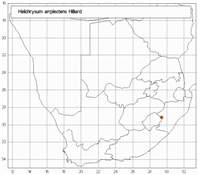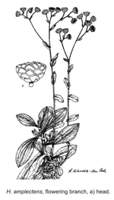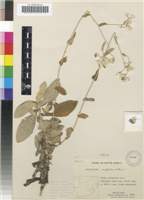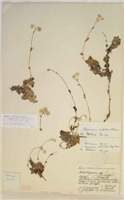Diagnostic characters:
Long slender flimsy inflorescence stalks
Description:
Straggly, loosely branched perennial herb, possibly up to 600 mm tall, base woody, branches erect or ascending, brittle, loosely woolly, flowering stems in the axils of dry withered leaves below new leafy growth, up to 400 mm long, slender, simple below, forking above into the lax inflorescence, loosely woolly, remotely leafy. Leaves on vegetative shoots crowded, those at the tips spreading, c. 30�80 x 10�30 mm, panduriform, apex subacute to subobtuse, base auricled, amplexicaul, upper surface thinly cobwebby, lower white-felted; leaves on flowering stems smaller, distant, oblong-elliptic becoming lanceolate upwards, base broad, cordate-clasping, indumentum as in primary leaves. Heads homogamous, broadly campanulate, c. 6�8 mm long, 10�13 mm across when fully radiating, 2�10 in a very open corymbose panicle. Involucral bracts in c. 7 series, graded, loosely imbricate, inner much exceeding flowers, bases woolly, tips obtuse or subacute, opaque, snow-white. Receptacle honeycombed. Flowers c. 100, yellow. Achenes 1,5 mm long, ellipsoid, glabrous. Pappus bristles 12�15, about equaling corolla, delicate, tips subplumose, bases not cohering.
Flowering in February.
Distribution:
Growing on rock ledges and crannies at the foot of cliffs on steep rocky S. facing slopes. Recorded only from Cleft Peak, Cathkin Peak and Monk's Cowl in the KwaZulu-Natal Drakensberg (Bergville and Estcourt districts) between c. 2 400 and 2 800 m.
Grassland Biome.
Taxonomy:
Literature:
Helichrysum amplectens Hilliard in Notes R. bot. Gdn Edinb. 34: 78 (1975), Compositae in Natal 231 (1977).
Type: KwaZulu-Natal, Bergville distr., Cathedral Peak area, Cleft Peak, c. 2 800 m, Nordenstam 2127 (NU; holo.; LD, iso.).
Synonym(s):
Vouchers:
Esterhuysen 20257 and 26100 (BOL; PRE).



